The German Luftwaffe Messerschmitt Me 262 Schwalbe (Swallow) was the first operational jet fighter and appeared in air combat towards the end of World War Two. The Me 262 has always been one of my favourite World War Two era aircraft. It wasn’t the best jet to ever grace the skies but I have always liked its shark like, leading edge design!
The Messerschmitt design team were on to something but the Me 262 was too late to ebb the tide of Allied bombers. Despite the late operational arrival, with its high-speed and swept wing it still managed to shape the future of jet fighter technology during the following Cold War.
Luftwaffe General and air ace Adolf Galland flew the Me 262 prototype on May 22nd, 1943 and called for immediate quantity production. He stated it was “As if angels were pushing” and “Not a step forward but a great leap forward”! Galland would finish the war with 104 aerial victories, 7 of them flying the Me 262 whilst commanding JV 44 between March 1945 and April 1945.


OPERATIONAL STATUS
Although the first jet engine prototype of the Messerschmitt Me 262A flew in 1942, it did not reach operational status until April 1944. The introduction of this jet fighter, truly cutting edge technology, was delayed for a number of reasons including engine development problems but significantly due to the meddling of Hitler who wanted them to carry bombs (requiring significant modifications) to be a high-speed revenge bomber under his Wunderwaffe program (“Miracle Weapons”), while the Luftwaffe wanted them to be a fighter, to intercept the never ending stream of Allied bombers raining destruction all over the Reich!
For a period of time production was directed towards bomber variants with limited rollout of fighters. The introduction in September 1944 of a dedicated Luftwaffe jet bomber, the Arado Ar 234 Blitz (Lightning) took the pressure off and allowed Me 262 fighters to get priority over the Me 262 bomber.
Eventually Luftwaffe generals such as Adolf Galland got the message through that the Me 262 was needed to shoot down Allied bombers. It took a while to prove the advantages of a jet fighter though!
The Allied bombing raids were also causing a shortage in parts and fuel and delaying production and deployment even further. Production of aircraft, parts and engines had to be dispersed to smaller factories, forests and even underground! The Nazi regime also resorted to using forced labour to produce aircraft – a dubious undertaking on a moral level at the best of times but also a major risk of deliberate poor workmanship and sabotage!
By October 1944 mass production of the Me 262 was occurring but only in relatively small numbers. In November 1944 just 101 were produced, 124 in December 1944, 160 in January 1945 and by February 1945 they finally completed larger numbers with 280 rolling off the production line. Never enough to counter the losses and the vast industrial might of the Allies.



The Me 262 was a revelation of speed in an era of high performance piston engine fighter aircraft. Powered by two Junkers Jumo 004B axial-flow turbojets enabled the Me 262 to fly at a maximum speed of 870 km/h (540 mph) which was around 160 km/h (100 mph) faster than a North American P-51D Mustang! Speed accompanied with 4 hard-hitting 30mm MK 108 cannons enabled the Me 262 the opportunity to inflict plenty of damage on slow moving Allied bombers (plus some were fitted with up to 24 x 55mm R4M underwing anti-aircraft rockets that could be fired in salvoes out of the range of the defensive machine guns of the Allied bombers) but the delay in service entry was a mistake that cost the Luftwaffe dearly in deploying a technological edge in a timely manner to protect their airspace.
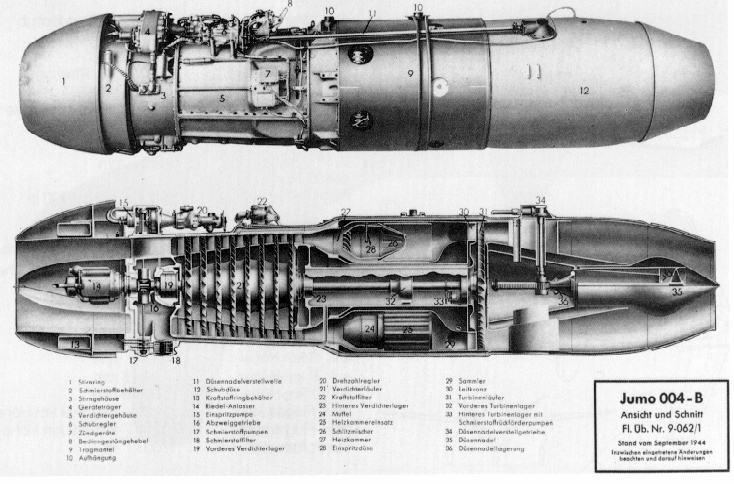
Unfortunately for the German pilots, unreliability and limited turbojet engine life also meant plenty of maintenance and downtime. During engine production high quality metals and alloying elements which would make the metal resistant to high temperatures could not always be used, resulting in metal fatigue and the need to overhaul the engines after 25 hours of flying and replace them completely after just 30-50 hours of flying! Constant or aggressive throttle changes could also lead to engine flameouts.
Although intended as a fighter aircraft, the primary role of the Me 262 was to target Allied bombers not fighters. Despite being significantly faster, the Me 262 was not as maneuverable as Allied fighters in tight turning air combat – it was a bomber interceptor, not a dogfighter.
First Encounters
Ivan Rendall discussed in some detail the first Allied pilot encounters with Me 262’s in July and August 1944 in his book Splash One – The Story of Jet Combat (1999 Edition). They make for interesting reading involving high speed Mosquito “Wooden Wonder” reconnaissance aircraft and the German jets!
The first confirmed Allied air combat with an Me 262 occurred on July 26th, 1944 when Luftwaffe Me 262 test unit Erprobungskommando 262 (EK 262) pilot Lt. Alfred “Bubi” Schreiber targeted a high flying de Havilland Mosquito photo reconnaissance aircraft from RAF No. 544 Squadron over Munich. The RAF pilot Flight Lieutenant A.E. Wall saw a German aircraft approaching and increased his speed to leave the enemy behind (as would normally happen) but was surprised that the German was suddenly alongside him to confirm the aircraft was Allied!
Schreiber quickly changed position to attack the Mosquito but the British aircraft could turn more quickly and was able to get out of his line of sight. Schreiber used his speed advantage to get back into position and opened fire but was unsuccessful in doing serious damage. This continued back and forth four more times before Schreiber attempted an attack from beneath the Mosquito. Wall evaded again and dived at full speed into clouds below, escaping the attack and getting safely back to Italy. This encounter signalled that high flying Allied reconnaissance missions were no longer invulnerable!
The first confirmed jet aerial victory occurred on August 8th, 1944, when EK 262 Pilot Lt. Joachim Weber shot down an RAF de Havilland Mosquito whilst its crew were on a photo reconnaissance flight over Germany. Weber would later fly with Jagdgeschwader 7 Nowotny (JG 7), the first full operational Me 262 unit.
It was not until a week later that the Allies had their first hard proof that Me 262’s were being used a fighter, when another photo reconnaissance Mosquito of RAF No. 60 (South African) Squadron was attacked by one repeatedly but despite wing and engine damage from cannon shells, managed to survive and escape the encounter by diving into clouds at low altitude! They crash landed back in Italy but had fortunately been running the reconnaissance cameras throughout the attack and had the photographic evidence the Allied commanders needed!
For Allied pilots the German jet delivered an element of shock and awe amongst them when they first saw the new jets slicing through the sky at incredible speeds, unleashing hell as they zipped through bomber formations! This advantage was short lived though, German jets were in short supply and Allied tactics were soon put into action to deal with the German jet menace.
USAAF fighter pilots soon developed a tactic to target Me 262’s when they slowed to turn or they would fly high above bomber formations so they could dive at high speed onto the German jets below. Another prime Allied tactic was to target the jet fighters at their most vulnerable when landing at their home air bases whilst low on fuel and flying low and slow or already on the ground. Me 262’s taking off were also slow as pilots could not push the engine too hard following startup. This tactic was known as “Rat Catching” amongst USAAF pilots and the Luftwaffe had to redeploy valuable Messerschmitt Bf 109G and Focke-Wulf Fw 190 fighter resources from targeting Allied bombers to protecting the jet bases!
Outcomes
Luftwaffe Me 262 pilots claimed a total of 542 Allied air to air victories in their deployment from April 1944 to May 1945 but they were restricted by engine problems primarily caused by a low operational life due to metal fatigue of low quality metals used in the Jumo 004 turbojet, fuel shortages and Allied attacks on their air bases (destroy the infrastructure and also target the Me 262’s landing or on the ground). Over 1,400 Me 262’s were manufactured but only around 300 entered operational service (as per previously mentioned due to technical, production, parts, fuel issues and shortages in trained pilots).
By 1945 the Luftwaffe could get enough Me 262’s into the sky here and there to make a formidable assault on Allied bomber formations. On March 18th, 1945 Jagdgeschwader 7 launched 37 Me 262’s to attack a vast formation of 1,300 plus Allied bombers, shooting down 8 of them, plus a fighter escort but losing 4 of their own in the air battle. Obviously this was a mere pinprick against the Allied air offensive and was all too late for the Luftwaffe, as there were never enough jet fighters to repel the vast number of Allied bombers but imagine the damage they could have done if Galland had been able to launch at once the hundreds of Me 262’s he had desired!
Me 262 losses were reported as only 100 in air to air combat but up to 1,200 Me 262’s were destroyed on the ground and in accidents – on April 10th, 1945 a formation of 55 Me 262’s went up to attack Allied bombers and by the end of the day 27 of them had been lost mainly to accidents! The jet age had come and changed air combat forever but it was all too late to help the battered Luftwaffe turn the tide of the air war over occupied Europe and Germany.
Variants
There were numerous Me 262 variants that became operational. These included the Me 262A-1a day fighter (interceptor/fighter-bomber), Me 262A-2a Sturmvogel (Storm Bird) dedicated bomber, Me 262B-1a two seat trainer, Me 262B-1a/U1 night fighter (fitted with a FuG 218 Neptun radar and Hirschgeweih eight-dipole antenna array – 15 were converted from training aircraft, the radar operator sat in the rear seat- only 10 were operational by February 1945 but they reportedly shot down 48 Allied aircraft in 70 sorties) and Me 262A-1a/U3, A-4a and A-5a unarmed reconnaissance aircraft variants with nose bulges to carry film for two Rb 20/30 cameras.
The fighter-bomber and bomber variants were at a major disadvantage with just a light bomb payload partnered with a very rudimentary bomb sight and due to the need for secrecy following the Allied D-Day landings in June 1944, pilots were required to fly at a higher altitude to keep out of sight and maintain a speed advantage. As such the effectiveness of their bombing missions was very limited and proved you shouldn’t put a wagon on a racehorse!


There were also numerous prototype only variants for testing of different combinations of weapons – Me 262A-1a/U1 with six nose mounted cannons (2 x 20mm and 4 x 30mm) and Me 262A-1a/U4 bomber destroyer with a BK-5 50mm nose mounted cannon – only about 300 of these 50mm cannons were produced before the war ended and Me 262 testing had not been completed – apparently the muzzle flash was blinding to the pilot, so it may not have gone much further in development! Experiments were also conducted with different engines – the more powerful BMW 003 turbojets proved unsuitable and even rocket engine boosters were tested. Prior to the two-seater night fighters, radar was fitted for trials to a single seat prototype designated Me 262A-1a/U2. There were even two Me 262A-2a/U2 bomber prototypes with a glazed nose for a bombardier!


There was also some experimentation of an Me 262 Mistel (Mistletoe) set up where a piloted aircraft was mounted above another that was essentially a drone aircraft packed with explosives that would be released towards a high priority target – earlier variants were deployed from 1943 with limited success (generally using a Junkers Ju 88 bomber as the Mistel and a piston engine fighter as the manned aircraft). Of numerous jet powered Mistel options the Me 262 combination was the only one to leave the drawing board but was not deployed.
Notable Me 262 Operational Units
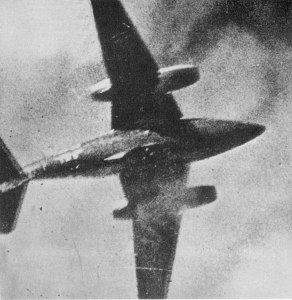
Major operational units to fly the Me 262 in air combat included:

Kommando Nowotny – formed in September 1944 and operational by October 1944 (based in Achmer and Hesepe), this unit was commanded by Austrian Major Walter Nowotny (258 victories – most on the Eastern Front, with 3 flying the Me 262 on the home front). The unit conducted interception missions to develop and test jet air tactics – The high speed of the Me 262 changed the way pilots attacked bomber formations as it only gave them a short period of time to attack in a fast pass (they also introduced the tactic of providing air cover to protect the Me 262’s upon landing).
Kommando Nowotny was formed from the disbanded Erprobungskommando 262 which was operational from April 1944 to September 1944 at Lechfield Air Base testing the Me 262 fighter. They began operations with just 23 fighter aircraft.
Kommando Nowotny claimed their first victory, a USAAF Consolidated B-24 Liberator bomber on October 7th, 1944 – they shot down three that day but also lost two fighters of their own to USAAF “Rat Catchers”. In the units first month of operation they shot down 50 Allied aircraft but lost 26 Me 262’s in the process!
Following air combat with USAAF fighters, Nowotny died in a crash flying Me 262 “White 8” on November 8th, 1944 due to engine failure and a fire. The unit was disbanded shortly after the crash. Possibly due to its experimental nature, along with dealing with early technical difficulties, the units 22 victories came at a high cost of 26 Me 262’s lost (8 due to accidents and mechanical failure). This unit was the basis for the operational Jagdgeschwader 7 Nowotny (JG 7).
Jagdgeschwader 7 was formed in January 1945 to become the first fully operational jet fighter unit of the war. JG 7 was in operation until the end of the war in May 1945. An accurate aerial victory tally by the unit against Allied bombers and fighters is unknown and varies widely from approximately 136 to 427 aircraft! Regardless of the number, ultimately the aerial victories were a minimal percentage of what was being sent over German held territory on a daily basis! Hauptmann Franz Schall, who died in a flying accident on April 10th, 1945 was the units leading jet ace achieving 14 aerial victories flying the Me 262 (137 victories in total).

Kommando Schenk – formed in June 1944 in Lechfeld, Germany from elements of 3./KG 51 under the command of Major Wolfgang Schenk (1913-2010, an air ace who flew 400 combat missions, 40 in the Me 262) to evaluate Me 262A-2a jet fighter-bombers and conduct bomber pilot conversion training. They operated from various locations until September 1944, when the unit was absorbed into I./KG 51 which was then converting to the Me 262. Schenk became the Geschwaderkommodore of Kampfgeschwader 51 at that time and from February 1945 to wars end was the inspector of Luftwaffe jet fighters.
Kampfgeschwader 51 “Edelweiss” (KG 51) (Battle Wing 51) was a bomber wing which served in the early Blitzkrieg campaigns and then on the Eastern Front until the end of 1943. For the rest of the war it served on the Western Front and in the defence of German home territory. Amazingly they converted to the Me 262 after flying lumbering Junkers Ju 87 Stuka dive bombers!
The introduction of Me 262’s in 1944 resulted in numerous desperate sorties against Allied ground forces in France, Belgium, Holland and Germany including sorties by I./KG 51 and II./KG 51 during the Battle of the Bulge in the Winter of 1944/45. Many aircraft were lost on the ground during Allied air raids and the unit seems to have been in constant retreat. I./KG 51 eventually surrendered to the American Army near Munich on May 8th, 1945 and II./KG 51 disbanded near Nuremberg on April 24th, 1945.
For the fighter-bomber and dedicated bomber Sturmvogel (Storm Bird) variants, Luftwaffe fighter-bomber and bomber pilots converted to the type. This cannot have been ideal for the bomber pilots, due to the high speed variance from a lumbering bomber to a state of the art jet fighter! Also the bomber pilots would have lacked air to air combat inexperience, which in a fighter-bomber would have been extremely different from flying in bomber defensive formations!

Jagdverband 44 (JV 44) was a very elite hunting squadron made up mostly of air aces led by Adolf Galland, which flew the Me 262A in the latter stages of the war. Galland selected experienced pilots whom he knew would be able to quickly convert from piston engine aircraft to a jet and make an immediate impact – men such as Gerhard Barkhorn (301 victories), Heinz Bär (220 victories – 16 flying the Me 262, making him the top ace in the type) and Johannes Steinhoff (176 victories). The top 5 aces in this squadron had over 1000 aerial combat victories between them (through the duration of the war) making it the most experienced combat squadron ever formed!
JV 44 was established at Brandenburg-Briest with approximately 60 Me 262A fighters but rarely had 16 airworthy at any one time. They operated out of Brandenburg-Briest from February 24th, 1945 to April 3rd, 1945. The unit then moved to Munich-Reim in Southern Germany until April 29th, 1945 – Adolf Galland flew his last combat sortie on April 26th, 1945 and downed a USAAF Martin B-26 Maruader medium bomber but suffered heavy damage to his aircraft, wounded he eventually crash landed at the airfield and managed to escape the wreck during a heavy strafing run by USAAF Mustang fighters! Following this incident, Heinz Bär took over command of JV 44 and the unit finally fled the Allied advance to Salzburg-Maxglan in Austria until May 3rd 1945, when the unit surrendered.
Despite all their experience, the impact of JV 44 was minimal though due to the squadron not becoming fully operational until just before the end of war in 1945 and the general lack of numbers of serviceable aircraft. They are reported to have shot down approximately 50 Allied bomber and fighter aircraft (including six USAAF P-47 Thunderbolt fighters in its last days of operation) and were known to have deployed R4M air to air rockets successfully on a number of occasions – in credit to the pilots this is said to have been a 4:1 victory ratio. Fuel shortages and airfields being shot up all the time did not help either! Before the end of the war the pilots destroyed their aircraft wherever possible to avoid them falling into Allied hands.


Other Me 262 units of interest:
Erprobungskommando 262 (EK 262) was formed at Lechfeld, Germany in 1944 under the command of Hauptmann Werner Thierfelder to train Luftwaffe fighter pilots who were converting to the Me 262. They were also tasked with developing tactics for the new jets.
EK 262 determined that formation take-off, with three Me 262 abreast was an ideal way of launching the jets quickly and in force (Lechfeld had wide runways). They also developed the best formation methods once in the air, which was to stay in a loose formation that required less throttle control adjustment of the turbojets to stay together and minimised the risk of engine flameout.
Kommando Stamp – an experimental night fighter unit established in November 1944 under the command of Oberleutenant Gerhard Stamp. Equipped with Me 262A-1a fighters, they were tasked with the defence of Berlin. The unit command soon changed to Oberleutenant Kurt Welter and was renamed Kommando Welter. The unit was redesignated 10./NJG 11 at the end of January 1945. From April 1945, this unit would operate several Me 262B-1a/U1 two-seat radar equipped night fighters out of Magdeburg.
Einsatz Kommando Braunegg – a jet reconnaissance unit with up to 7 camera equipped Me 262A-1a/U3 aircraft. Formed in November 1944, the unit conducted operational reconnaissance missions over Allied lines during December 1944 and January 1945. The unit became Nahaufklarungsgruppe 6 in mid January 1945 and had 8 aircraft on strength in April 1945 but 3 were lost in an Allied air raid that month. The unit continued to conduct reconnaissance missions until disbanded in May 1945.
Captured & Tested
At the end of the war the Allies snapped up as much of the German jet technology as possible – aircraft, plans, engines, parts and experts. Numerous captured Me 262 aircraft ended up in the hands of the Americans under “Operation LUSTY” – (LUftwaffe Secret Technology) the Air Technical Intelligence teams commanded by Colonel Harold E. Watson aka “Watson’s Whizzers” collected whatever they could find aircraft and weapons wise, and another team looked for documents and recruited suitable German candidates for post war work too.
Me 262’s also were captured by the British and Soviets for further examination and testing. The lessons learned from German swept wing designs with wing slots were put to use in developing jet fighter aircraft such as the Mikoyan Gurevich MiG-15 and North American F-86 Sabre.
A number of these aircraft are the survivors of today. Unfortunately post World War Two others were lost in accidents, damaged beyond repair or simply scrapped.




The USAAF “Watson’s Whizzers“ gave their Me 262 aircraft various n byicknames and painted them on the nose of each aircraft before they were shipped to the United States (they seem to have been mostly painted over after they made it stateside). Women’s names seem to be the norm, such as “Beverly Anne“, “Connie… My Sharp Article“, “Julie“, “Lady Jess IV“, “Marge“, “Pauline“, “Vera” and “Wilma Jeanne“. Others received names (or were later renamed) like “Deelovely“, “What was it?“, “Happy Hunter II“, “Pick II“, “Screamin Meamie” and “Ole Fruit Cake“.



SURVIVORS
Only nine surviving original Messerschmitt Me 262 aircraft exist today. Plus a pair of post war Czechoslovakian variants.
GERMANY
Munich 262
In 2010 I saw 1944 Messerschmitt Me 262A-1a/R7 (Werk Nummer 50071) “White 3” (III./JG 7) a the Deutsches Museum in Munich. This survivor includes an /R7 Rüstsatze (field modification kit) underwing installation of wooden racks for 12 x R4M air to air rockets.

“White 3” has an interesting back story. It was flown to Switzerland on April 25th, 1945 when, extremely low on fuel, pilot Hans Guido Mutke had to make an emergency landing at Dübendorf. He apparently wanted to avoid capture by Allied troops, so neutral territory seemed the safest place.
Seized by the Swiss, interestingly they never test flew the aircraft and put it into storage instead. There it sat until returned to the German government in August 1957!


Deutsches Technikmuseum Berlin is restoring a static Me 262A-1a jet fighter from various parts and new build components (according to Preserved Axis Aircraft the main identifiable aircraft is Werk Nummer 111006). The Luftwaffe Museum replica features an original Me 262 nose section and some parts such as panels from the engine nacelles.
AUSTRALIA
Australian War Memorial
Within the Striking by Night exhibition of the Australian War Memorial sits a jewel in the crown of this excellent collection, a Messerschmitt Me 262A-2a fighter-bomber known as “Black X” because of the distinctive Luftwaffe KG 51 unit markings on the nose wheel undercarriage door and fuselage. This example was presented to Australia as a war trophy following British testing at the end of the war. It is said to be the only surviving bomber variant.

“Black X” was manufactured by Messerschmitt at Regensburg-Obertraubling, Germany in March 1945 (Werk Nummer 500200) as a fighter-bomber version and flew with the Luftwaffe Kampfgeschwader 51 (KG 51 – Battle Wing 51) in its final months of operation in 1945 in Czechoslovakia. KG 51 reportedly had less than 40 Me 262’s at any given time and were tasked with fighter-bomber and bomber intercept missions against Allied bomber formations from mid 1944 until May 1945.
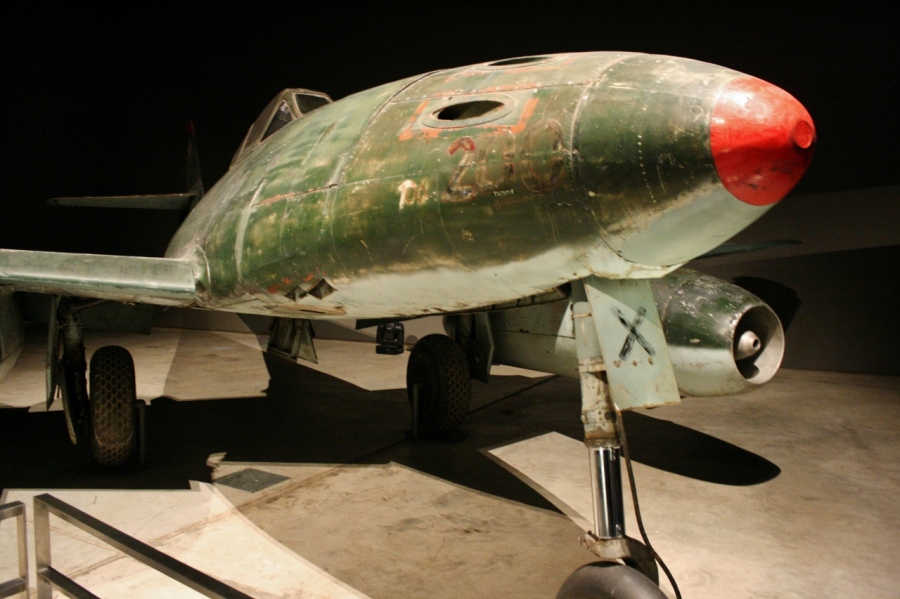
In May 1945 the Me 262 was flown by pilot Lieutenant Froelich to Fassberg Airfield, Germany that was then in Allied territory and surrendered to the British. In late August 1945 it was flown out of Germany, arriving on September 6th, 1945 at the Royal Aircraft Establishment in Farnborough, UK for testing where it was flown nine times by test pilots before being sent to Australia.

The aircraft is said to have evidence that its guns were fired in combat (the spent cartridge chutes are apparently dented indicating shell ejection) and is unique in that it is the only one left with the original 1945 thin coating of German paint work. Additional paint work on the fuselage includes the 1945 British Air Ministry markings whilst under testing at Farnborough (“P” for prototype and “AIR MIN 81” – it also had British roundels painted over the German markings prior to restoration work) and a 1950’s era over-paint by the RAAF.
Despite appearing mostly intact, numerous parts are missing from the Me 262A-2a. Somewhere along the way the nose-mounted bomb pylons were removed, a number of cockpit instruments are also missing, as are the two Riedel motor starters. A number of doors and panels are also missing, including the plywood lower port wheel door, the side opening nose wheel door, a starboard side radio access panel and a large ventral panel from in front of the wheel bays.
UNITED KINGDOM
RAF Museum 262
When I last saw Messerschmitt Me 262A-2a (Werk Nummer 112372) “Yellow 4” (3/JG 7) in 2012, it was located at RAF Museum Hendon but it has since been relocated to RAF Museum Cosford. This aircraft was built in 1945 and originally coded as “Red 2”. Captured by the RAF at Schleswig-Jagel, Germany, it was flown to England and assigned the RAF Serial Number VK893 for flight testing by the Royal Aircraft Establishment at RAF Farnborough.

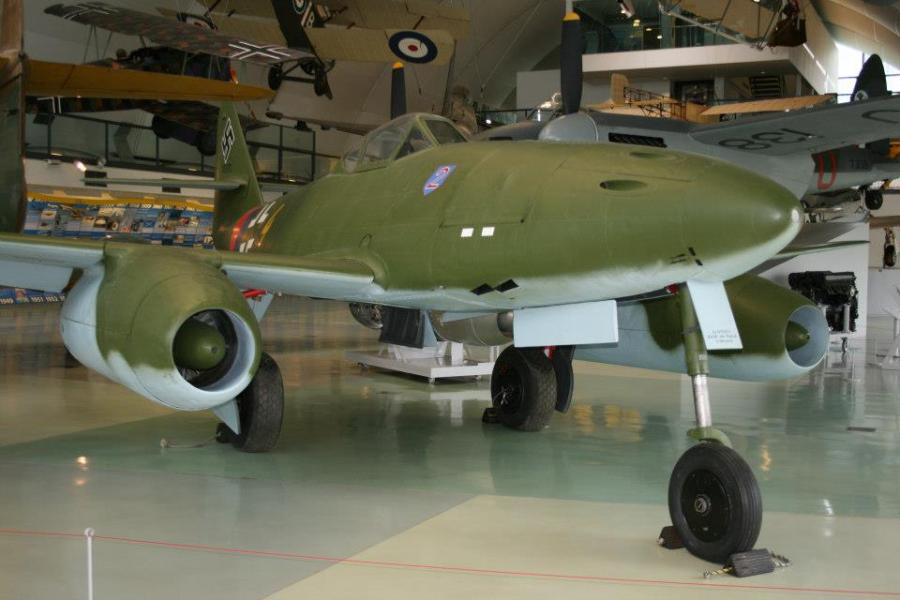
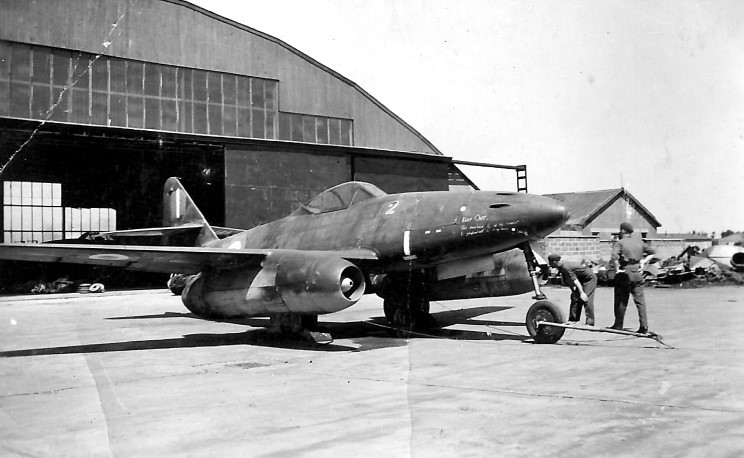
UNITED STATES
National Museum of the US Air Force
Messerschmitt Me 262A-1a (Werk Nummer 501232) “Yellow 5” (3/KG 6) was dubbed upon capture by “Watson’s Whizzers” firstly as “Beverly Anne” and later “Screamin Meamie“. It was shipped to the United States in 1945 for flight testing with the US Navy Armament Test Division at NAS Patuxent River in Maryland (allocated the BuNo. 121442). Restored at Kelly Air Force Base in Texas between 1976 and 1979, it is displayed at the National Museum of the US Air Force without unit markings to represent an aircraft straight off the production line.


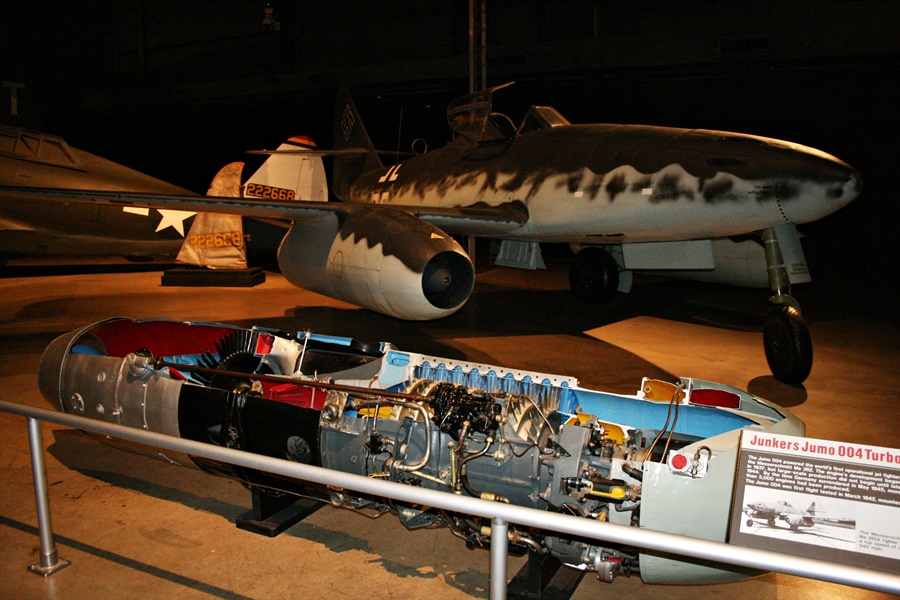



Smithsonian National Air and Space Museum
The Smithsonian Messerschmitt Me 261A-1a Schwalbe (Werk Nummer 500491) “Yellow 7” fighter flew with Jagdgeschwader 7 (II./JG 7). Its pilot was Heinz Arnold (he was credited with 49 aerial victories – 42 Soviet piston engine fighters and 7 USAAF bomber and fighter aircraft including 3 North American P-51 Mustangs – the USAAF victory claims where whilst flying the Me 262), then after his death flying another Me 262, it was flown by a Lt. Muller until the end of the war.
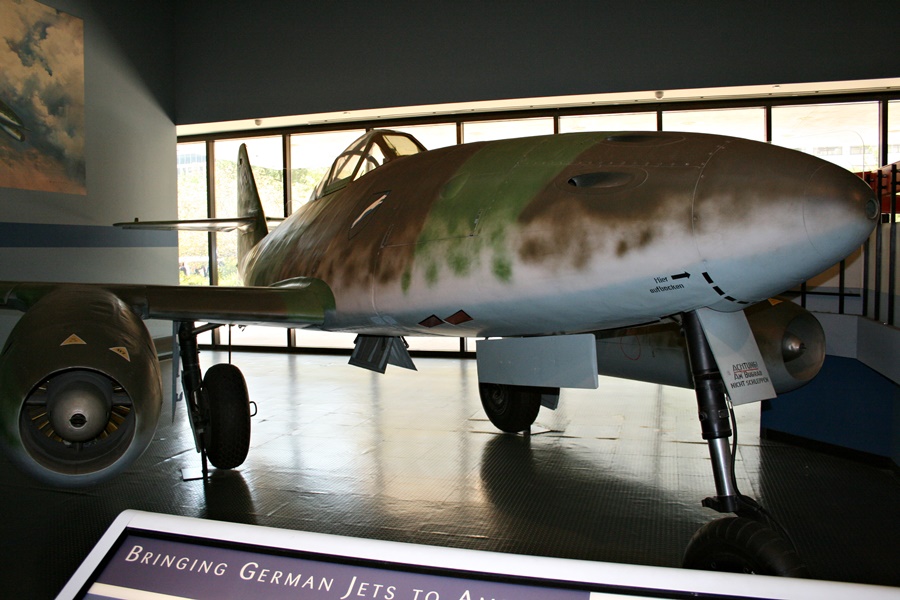
The jet was captured at Lechfield in Germany in 1945 and was designated as “Watson’s Whizzers” number 888 with the name “Dennis” (after the son of the sargeant who accepted its surrender) but was quickly renamed “Julie” and then “Ginny H” before being shipped with numerous other German aircraft back to the United States aboard the Royal Navy HMS Reaper aircraft carrier. The Me 262 found its way to USAAF Freeman Field in Indiana for testing.

At some stage the fighter nose was switched with a reconnaissance variant from a captured Me 262A-1a/U3 (Werk Nummer 500453 – now restored at the Flying Heritage and Combat Armour Collection) which was being tested by the Hughes Aircraft Company in flight comparisons with a new prototype Lockheed XP-80 jet fighter. Placed in storage in 1946 before being transferred to NASM in 1950, the Me 262A-1a went back into storage for a few decades until restoration work began in 1978. It was apparently quite a battle to get the original nose back in place and also to clean out all the corrosion that had formed over 30+ years (6,077 hours of restoration)! I have been to this excellent museum numerous times and this aircraft is always a highlight to see.
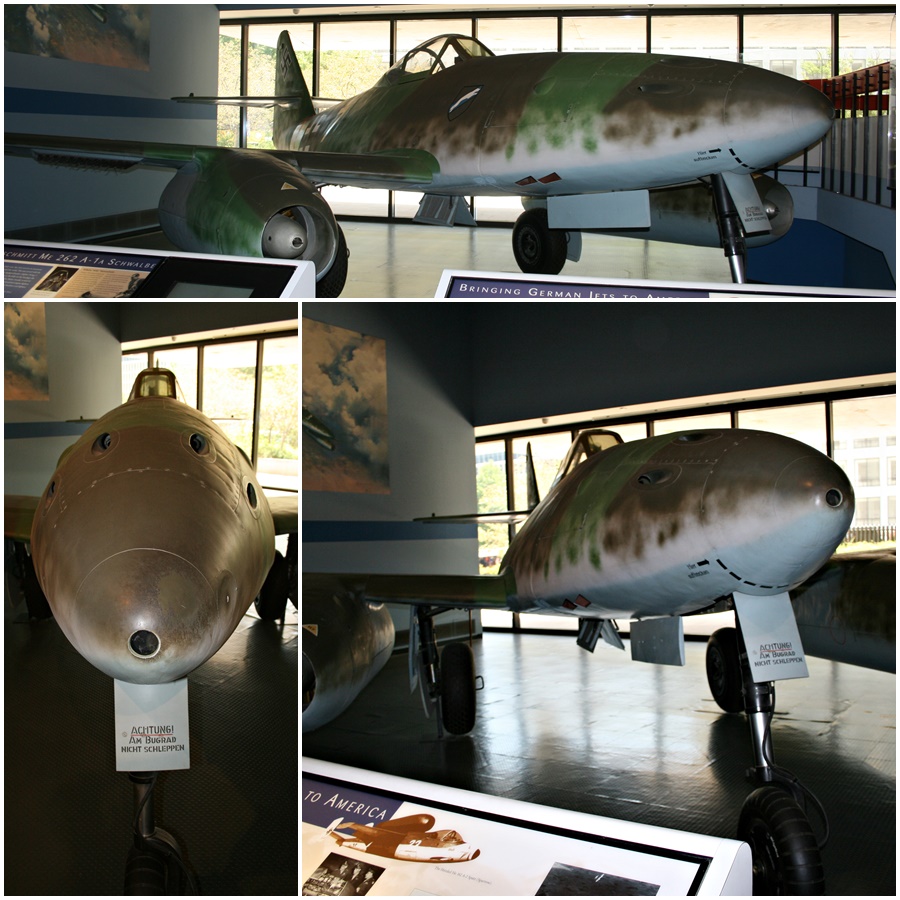
National Museum of Naval Aviation
The National Museum of Naval Aviation in Pensacola, Florida has Luftwaffe Messerschmitt Me 262B-1a (Werk Nummer 110639) “White 35” two seat training variant (III./EGJ2). A rare survivor as only 2 original Messerschmitt two seaters exist today – the other is a night fighter Me 262B-1a/U1 located in South Africa. There is also a Czech built Avia CS-92 two-seat trainer in Prague (see below).


This trainer was captured in complete condition at Schleswig in May 1945 and dubbed “Vera” by the “Watson’s Whizzers” team. With the aid of former Luftwaffe pilots, the Me 262B-1a was used to train USAAF pilots who were going to fly the captured Me 262’s to the port of Cherbourg for shipping to the United States.
Once stateside the US Navy conducted flight testing at Naval Air Station Patuxent River in Maryland (allocated BuNo. 121448). Put into storage in 1946 at Willow Grove Naval Air Station in Pennsylvania, it eventually ended up in the hands of the Wings of Freedom Museum for many years before being transferred to the national museum. In 1993 the US Navy allowed Legend Flyers at Paine Field in Everett Washington to borrow this as a pattern aircraft for their Me 262 Project flying replicas (see below).

Flying Heritage and Combat Armour Collection
The Paul G. Allen Flying Heritage and Combat Armour Collection at Paine Field in Everett Washington includes Messerschmitt Me 262A-1a/U3 (Werk Nummer 500453) “White 25”, originally a reconnaissance variant that has been restored with reconstructed Junkers Jumo 004 turbojet engines with modern, reliable metals to return the aircraft to flight. One of those captured in 1945, it was returned to the United States for flight testing at USAAF Freeman Field in Indiana, including flight comparison tests by the Hughes Aircraft Company against a Lockheed XP-80 Shooting Star prototype jet fighter – during flight testing, a fighter nose was installed to replace the less streamlined reconnaissance one, which had camera film bulges.

Previously Me 262A-1a/U3 (Werk Nummer 500453) had been in the Planes of Fame collection in Chino, California. The aircraft is still under restoration off site at the Flying Heritage and Combat Armour Collection facility in Arlington, Washington. I cant wait to see this one in person some day but for now you can see an update on its status as of April 2019 via Warbird News here (FHCAM have repainted it to represent its wartime Luftwaffe reconnaissance livery).
SOUTH AFRICA
South African National Museum of Military History
I am yet to see the Messerschmitt Me 262B-1a/U1 (Werk Nummer 110305) “Red 8” (operated by 10/NJG 11) two seat night fighter in the South African National Museum of Military History. I was in Johannesburg in 2004 but back then my priority was nature and wildlife, so I missed out!
This is the only surviving night fighter. This variant was crewed by a pilot and radar operator, and is fitted with a FuG 218 Neptun radar and Hirschgeweih (stag antler) eight-dipole antenna array.
The night fighter was captured by the RAF at Schleswig-Jagel, Germany in May 1945 and flown to England on May 19th, 1945. The Royal Aircraft Establishment (RAE) conducted flight and radar tests at RNAS Ford from July 6th, 1945 (it was given RAF Serial Number VH519) – it was actually damaged on its first landing there but was soon repaired for flight. This was one of three night fighter versions taken for testing by the RAE but unfortunately the other two were destroyed in 1947 – Werk Nummer 110635 “Red 10” was reportedly scrapped by No. 6 Maintenance Unit (MU) at Brize Norton and Werk Nummer 111980 “Red 12” was lost in a storm also at Brize Norton.
The aircraft was shipped to Cape Town, South Africa as a war trophy in early 1947 and was put into storage for many years. It became part of the museum collection in the late 1960’s and was restored in 1971 for display in the museum from 1972 onwards.
CZECHOSLOVAKIAN 262’s
Prague Aviation Museum
By 1945 a number of German Luftwaffe Messerschmitt Me 262 jet fighters were located in Czechoslovakia. During the war Czechoslovakian factories such as Avia produced Me 262 airframe components, jet engine parts and even final assembly of the jet fighter. As a result blueprints, technical manuals, production facilities, numerous spare parts, Junkers Jumo 004 axial-flow turbojet engines and a number of usable Me 262 airframes were available to bolster the Czechoslovakian Air Force after the end of World War Two and plans were quickly put into place to complete as many aircraft as possible and bring the Czechoslovakian Air Force into the jet age.
The first Czechoslovakian built Me 262A-1a jet fighter was completed by Avia as early as December 1945 and were designated as the Avia S-92 Turbina (“Turbine”). The first S-92 test flight was conducted on August 27th, 1946 by Antonin Krause, Avia’s chief test pilot and 7 S-92 fighters were produced (the first prototypes were S-92.1, S-92.2 and one following aircraft was trialled unsuccessfully with BMW 003 turbojet engines but reverted back to the Jumo 004B – the turbojets were refurbished by Avia and designated M-04) along with 3 Me 262B-1a two-seat trainers designated as CS-92 (the first flew on December 10th, 1946). Fortunately a single S-92 and CS-92 were preserved at the Prague Aviation Museum and remain as the only Avia survivors.


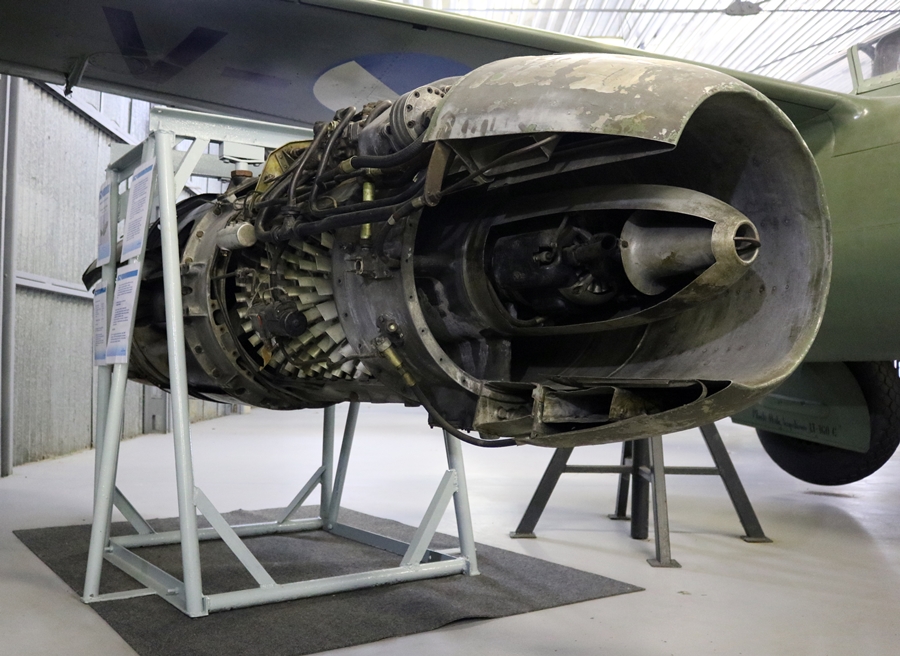
The S-92/CS-92 aircraft were part for part copies of the German fighter and had the same standard armament of four Mk 108 30mm cannons and similar speed performance. The first Avia S-92 fighters were delivered to the Czechoslovakian air force in 1947 but a full squadron was not formed for a few years. The Czech 5th Fighter Squadron flew the S-92/CS-92 from Kbely Airbase from 1950 to train pilots in the new age of jet flying.
The Czechoslovakian engines suffered the same longevity issues of the wartime German Me 262’s but Czech pilots managed to coax up to 60 hours flight time out of them (with careful flight control management and constant maintenance). The advent of new Soviet MiG-15 jet fighters, meant the S-92/CS-92 jets were soon retired and by 1951 were relegated to ground instructional airframes.

Single seat Avia S-92 (V-34) was the fourth produced and upon retirement had been in the National Technical Museum collection until transferred to the Prague Aviation Museum in 1979. Restoration of this aircraft was completed by museum staff in 1987. The gun armament seems to have been removed during its ground instructional airframe days and the gun ports have been covered over.
Following retirement, two-seat Avia CS-92 (V-35) became a ground instructional airframe at the Military Technical Academy in Brno. Transferred to the Prague Aviation Museum collection in 1967, no major restorative work was commenced until 2009, then it went back into storage. For some reason it has been repainted from Czechoslovakian Air Force livery and markings to a German Luftwaffe scheme that represents an aircraft found at Žatec in 1945!



REPLICAS
Legend Flyers at Paine Field, Washington commenced the ME 262 Project to produce five replica Messerschmitt Me 262A & B variants with modern reliable General Electric C610 jet engines. They were sold to US and European buyers as flyable aircraft.
The variants produced include an Me 262A-1c fighter (replica designation for an A-1a), two B-1c (replica B-1a) two-seat trainers and two convertible A/B-1c that can be switched between a single or two-seat variant. The “c” refers to the C610 engine.

Interestingly they were assigned a Werk Nummer that continued on from the original Messerschmitt final production number i.e. 501241 “White 1” – a B-1c two-seater operated by the Collings Foundation, A/B-1c 501243 – a “convertible” operated by the Military Aviation Museum in Virginia and A/B-1c 501244 – another “convertible” operated by the Messerschmitt Foundation in Germany. I have seen a number of these, including a “convertible” at Legend Flyers (“White 3”), the non flying single seater at the Evergreen Aviation & Space Museum in Oregon (displayed with R4M air to air rockets) and the A-1c flying in Germany. Although not the real deal, they are still cool to see!




The Me 262 takes its place as a significant contributor to jet development in the history of aviation. A flawed marvel of its time!
This blog was originally posted on Aces Flying High – The Survivors on May 8th, 2019
References:
Australian War Memorial – Me 262
The Aviation History Online Museum – Messerschmitt Me 262 Schwalbe
Classic Wings – Axis Preserved Aircraft – Me 262
IndianaMilitary.org – Me 262A Ohio
National Museum of the USAF – Me 262
National Museum of the USAF – Operation LUSTY
National Naval Aviation Museum – Me 262
SilverHawkAuthor.com – Axis Warplane Survivors, German Aircraft (Part IV)
Smithsonian – National Air and Space Museum – Me 262A-1a
Splash One – The Story of Jet Combat by Ivan Rendall (1999 edition)
Stormbirds – Men & Units. The pilots who flew the Me 262
Stormbirds – Me 262 Project (Legend Flyers)
ThoughtCo. – Messerschmitt Me 262 Used by the Luftwaffe
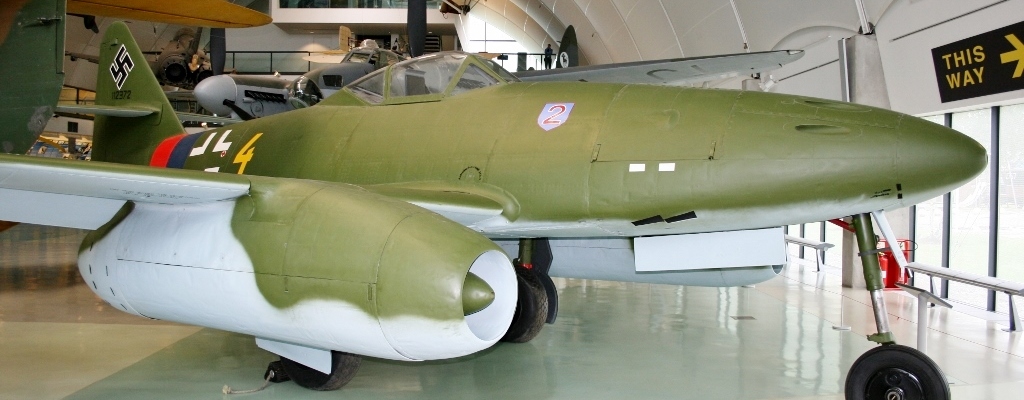
A really thorough and excellent account of the Me 262.I really enjoyed it and thank you for sharing it with us. I’ve just finished “Hitler’s Jet Plane” by Mario Ziegler which is something you might enjoy.
LikeLiked by 1 person
Thanks. Sounds like a good read. I will see if I can track it down
LikeLike
What a great post, so well researched and full of information. I have visited the one at RAF Cosford Museum.
LikeLiked by 1 person
Thanks Mike!
LikeLike
Excellent post! The Me-262 has always intrigued me; it was contemporary to the Gloster Meteor and Lockheed P-80 Shooting Star, yet had a far higher profile. I guess it was a reflection of the differing philosophies between the Allies and the Germans. I’ve yet to see a Me-262 ‘in the flesh’, as it were, but it’s certainly on my bucket list.
LikeLiked by 1 person
Thanks Matthew. If you ever get to Canberra check out Black X. The German jets always stole the limelight!
LikeLiked by 1 person
Very interesting reading indeed, and a great looking aircraft.
LikeLiked by 1 person
Thanks. It was quite the innovation!
LikeLiked by 1 person
You always amaze me Deano.
LikeLiked by 1 person
Thats quite the compliment! Thanks Pierre
LikeLike
Great read! One thing to mention though and to quote “Interestingly they were assigned a Werk Number that continued on from the original Messerschmitt final production number” making them late production and original late production Me 262 jets. Conclusion, these ARE the real deal, not just a reproduction.
LikeLike
Its a stretch!
LikeLike
what about the one from willow grove nas,that is now in the navy air muesuem in fla.
LikeLike
It is featured. That is the two seater
LikeLike
Interesting post – thanks – I cannot seem to work out the numeral meaning on the fuselage photos of which there are many across the internet – yours is the first to show a 4 that no one mentions. If it was just a 7 next to the cross , does that mean say js7 the unit number meaning no aircraft had unique identifiers?
LikeLike
Thanks – the colour depicts the Staffel number and the number denotes which aircraft it was in the Staffel. This will help: https://youtu.be/eH7me9EY7BE
LikeLiked by 1 person
Thanks Deano
LikeLiked by 1 person